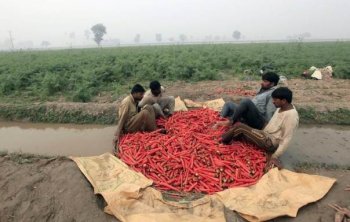
Since she started out in the 1970s, she has overcome increasingly erratic rainfall by using new technologies and trying out different crops and trees. She even turns her animal manure into biogas, harnessing methane for clean energy.
And she doesn't stay quiet about it. Gachanga hosts groups of other Kenyan farmers and international researchers on her farm to show them the effectiveness of a mixed crop, livestock and tree farming system in the face of worsening climate pressures.
"We try to help ourselves so that climate change will not affect us," she told a discussion about supporting farmers on the sidelines of the recent climate change talks in Paris.
It is a strategy that has worked well for her. Over the years, she has been able to build a stone house for her family of 11 children, connected to power and water supplies.
"Farmers need to get enough crops to sustain their family and reduce poverty, and educate their children," Gachanga said.
However, millions of others are struggling to maintain their yields amid crop damage from severe droughts or flash floods, with no assets in reserve to help them bounce back from a crisis.
The International Food Policy Research Institute released a study in Paris showing that climate change is a threat to agricultural growth, affecting productivity, prices and a new global goal to end hunger by 2030.
In the Philippines, for instance, climate change is projected to cut per-capita consumption of cereals by 24 percent and fruits and vegetables by 13 percent, increasing the number of people at risk of hunger by 1.4 million in 2030 and 2.5 million by 2050, the institute said.
First for food security
Given that, it is surprising the world ‘agriculture’ does not appear once in the text of the new global agreement to tackle climate change adopted in Paris on Saturday. A key reason for this is that developing nations long resisted including agriculture in the climate negotiations, fearing efforts to feed their people would be compromised by pressure to reduce planet-warming emissions from farms.
A 2015 study from the U.N. Food and Agriculture Organization (FAO) found that emissions from agriculture are growing, accounting for around 11 percent of the global total in 2010.
The Paris climate agreement refers only indirectly to agriculture, in terms of making sure people have enough to eat. Its non-binding introduction recognises ‘the fundamental priority of safeguarding food security and ending hunger, and the particular vulnerabilities of food production systems to the adverse impacts of climate change’.
The binding part of the deal states that boosting the world's ability to adapt to those impacts and foster climate resilience and low-emissions development should be done ‘in a manner that does not threaten food production’.
Yet, despite the politics that largely excluded agriculture, the FAO welcomed the agreement, noting that for the first time ever, food security features in a global climate change accord.
"This is a game-changer for the 800 million people still suffering from chronic hunger, and for 80 percent of the world's poor who live in rural areas and earn income – and feed their families – from agriculture," FAO Director-General José Graziano da Silva said in a statement after the deal was reached. "By including food security, the international community fully acknowledges that urgent attention is needed to preserve the well-being and future of those who are on the frontline of climate change threats."
Paying for plans
Others in the agricultural research community and agencies working with small farmers highlighted the widespread inclusion of agricultural policies in the nearly 190 national action plans submitted to the United Nations as a basis for the climate deal.
Analysis by the CGIAR Research Programme on Climate Change, Agriculture and Food Security (CCAFS) shows agriculture is discussed in 80 percent of those plans, a signal that addressing agriculture in the context of climate change is a priority.
Kanayo F. Nwanze, president of the International Fund for Agricultural Development (IFAD), said this was a good springboard for approaching top decision makers in developing countries about protecting their farmers from climate change.
In a report released in Paris, IFAD said technical interventions, like hardier seeds and accurate weather forecasts, are not enough to help small farmers cope, and must be backed up by national strategies, laws and budgets.
One major barrier to helping small-scale farmers adapt to extreme weather and reduce emissions from their activities is insufficient money for research and action on the ground, experts noted. The CCAFS study of national climate plans found the 48 least developed countries alone will need funding of $5 billion per year - $3 billion for adaptation and $2 billion for reducing farm emissions.
That sum is much higher than current commitments to climate funds for agriculture, and at least 10 percent more per year than multilateral climate funds spent on agricultural projects in the last decade, it said.
"Climate finance needs to include agriculture as a key sector, and support countries to implement the plans they have laid out," said CCAFS director Bruce Campbell.
Source: Megan Rowling; editing by Ros Russell of the Thomson Reuters Foundation, the charitable arm of Thomson Reuters, that covers humanitarian news, women's rights, trafficking, corruption and climate change. Visit: www.trust.org
Photo: Farmers wash carrots in a polluted stream during harvest season at a farm on the outskirts of Faisalabad, Pakistan, 8 Dec. 2015. REUTERS/ Fayyaz Hussain



 Classifieds
Classifieds

